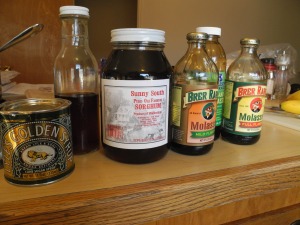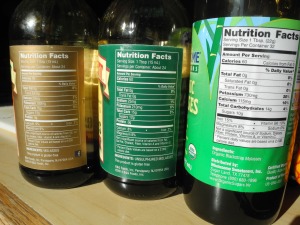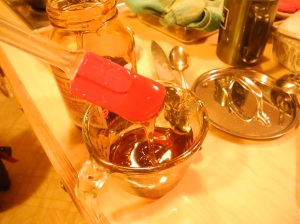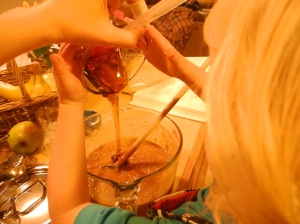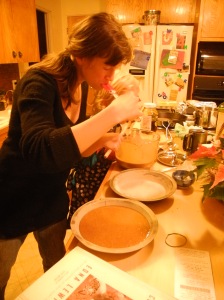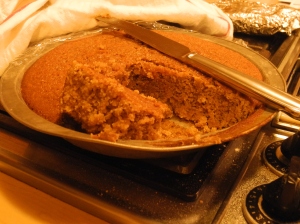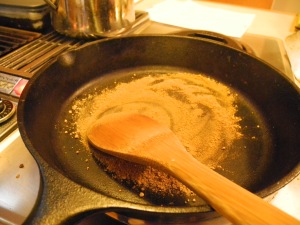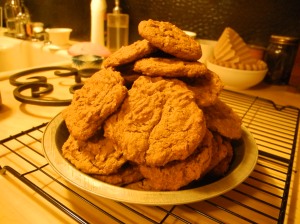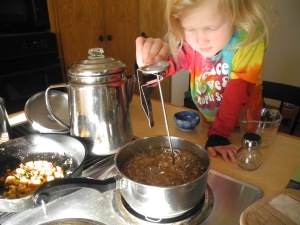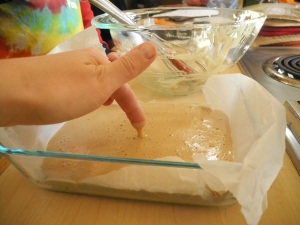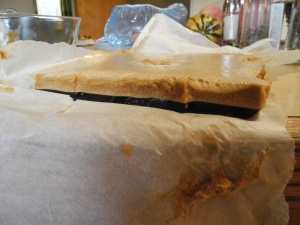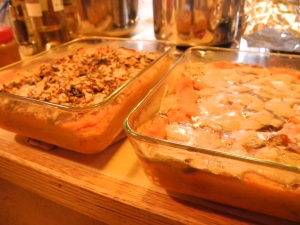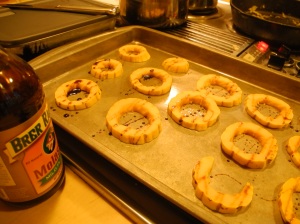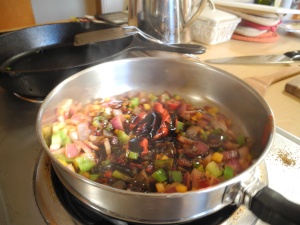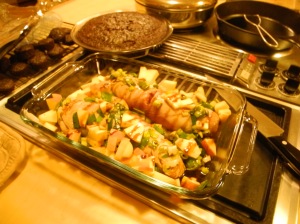The Other Maple Syrup: Celebrating Molasses
Maple syrup is not the only sweet liquid around. In fact, for those of you who are confused by the term “sugaring”, it’s a recently new way to consume maple. Maple sap used to be boiled down past the point of syrup and into sugar – as sugar it didn’t spoil, was easier to store, and was easier to transport. Conversely, molasses, a syrup derivation of cane sugar, was consumed more frequently than granulated, “company” sugar.
Obviously in my kitchen I favor using maple syrup over other sweeteners. However this time of year I start thinking about gingerbread in all its glorious forms which leads me straight to molasses. But rather than obsess about the perfect gingerbread recipe (not my forte) I decided to celebrate and explore molasses and a couple of its counterparts: sorghum syrup and other cane syrups.
Let’s first discuss what these sweeteners actually are. Sorghum syrup or sorghum molasses is made from sweet sorghum*. Molasses, cane syrup, and golden syrup are made from sugarcane. Both sweet sorghum and sugarcane are grasses with sweet stalks. The viscous liquid pressed from the crushed stalks becomes these various sweet syrups.
Sorghum molasses, though difficult to find, is fairly straightforward. However, the sugarcane syrups are a mess to figure out. I’ve read alternately that the first pressing of the crushed stalks leads to cane syrup, fancy molasses, or mild-flavored molasses. If you’ve got cane syrup (and good luck, I could not find it anywhere in stores and didn’t care to order it online), you can then strip it of its glucose to make golden syrup**. The second pressing leads to full-flavored molasses. I think. And then everyone is in agreement (at last!) that the third pressing of the sugarcane stalks makes blackstrap molasses. Now, sugarcane is a plant and does actually have some beneficial minerals. These minerals never make it into the highly processed white sugars, but they reappear in increasing concentrations in the molasses. I compared the nutrition labels of the mild-flavored, full-flavored, and blackstrap molasses and was surprised: both the mild and full-flavored have 3% of the RDV of iron, but the blackstrap has 15%! Blackstrap molasses has all kinds of other purported health benefits (read here for a fascinating list, and ladies, take note of the purported effect on menstrual cramps).
Now, just because I’m not obsessed with finding the perfect recipe for gingerbread doesn’t mean I’m not having fun playing with various recipes and eating gingerbread everyday. Here’s what I’ve got:
- mild-flavored molasses is lovely in cake but it doesn’t quite create a real gingerbread experience. I made a super-yummy chocolate-gingerbread cake (mine came from the cookbook Gingerbread but you can google chocolate-gingerbread cake and find a dozen recipes) with both the mild and the full flavored molasses and they were each delicious in their own way. The two look exactly alike but the qualities and flavor truly are different. I preferred the mild-flavored with this chocolate variation cause I was loving the chocolate. But again, I decided to go full-flavored for my next variations to maintain more of a traditional gingerbread intensity.
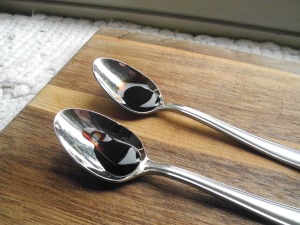
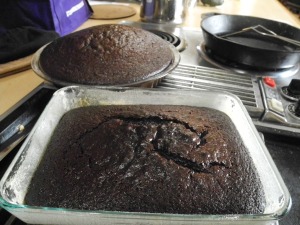
- Beer and molasses might belong together. Seriously. I made a gorgeous molasses-ginger-stout cake that was incredibly moist without being at all heavy. I think the carbonation does the trick, so I’d be curious to try it with seltzer or something if I didn’t have any beer. But… why wouldn’t I have beer? Look for the recipe in Dishing Up Oregon.
- Sorghum molasses is fascinating stuff. It has a texture more akin to honey than maple syrup or molasses. I made an Edna Lewis gingerbread cake and it came out lighter in color than a traditional gingerbread with a big, crumblier crumb that reminded me of coffeecake. This recipe called for a cup and a half of the sorghum molasses as opposed to the cup or so usually called for in recipes of the same size. However it did not call for any additional sweeteners whereas every other recipe I looked at used molasses in addition to white and/or brown sugar. The result is a not too sweet, almost light but still satisfying gingerbread. I think I found my go-to breakfast gingerbread. Thank you, Edna!***
On to cookies. Typically, there are three different approaches to cookies with molasses. (1) These are the gingersnaps, very snappy and crisp and heavy on the gingery quality. (2) These are the gingerbread men. Or ninjabread men if you’re lucky enough to have a sister like mine. These are heavier on the molasses but with that almost stiff sugar-cookie quality so you can roll the cookies out. (3) These are the soft molasses cookies with more molasses than ginger and spice. I’ve tried and liked all these recipes but oh man, there is a new kid in town. One Sweet Cookie features a molasses drop cookie that combines the zest of the gingersnap with the deep darkness of molasses. The trick? Toast the spices. Toast them! Yes, it is an extra step but it is so so so worth it. And I didn’t have fresh ginger for the recipe or candied citrus (and I’m not sorry cause I hate fresh ginger in baked goods and I don’t want to keep candied citrus in my pantry) so I substituted minced candied ginger and it rocked. Go make a molasses ginger cookie with toasted spices!
Marshmallows. Oh marshmallows. I’ll be making a real chock full of experimenting marshmallow post one day when I don’t have a four-year old and an 8-month old. For now I (mostly) followed the molasses-maple marshmallow recipe from Gingerbread to make a yummy marshmallow that ended up on our yams at Thanksgiving. It’s a funny thing though. Jet-puffed marshmallows have taken us far far away from real food. Real marshmallows don’t scorch on the top, don’t have a solid-like exterior around a delicious mushy interior, and they sure don’t float in your hot chocolate. They do separate if there is something heavy in them like, oh I don’t know, molasses. You end up with a molasses and gelatin jello-y bottom layer and a maple sponge-y top layer. I have a sneaking suspicion that my tinkering with the recipe and refusing to use corn syrup played a role in this, but again, that kind of research is for another day. Regardless, these were delicious and a blast to make. Take-home message: molasses can be a fun thing to play with in your candy and confection making this holiday season. The book Gingerbread has great confection recipes and is worth buying if you love molasses and all things gingerbread.
A couple of notes regarding all of the above. I bought the molasseses (can that be the correct plural?) as I encountered them at the various stores I frequent, i.e. I am not trying to advertise or push one brand above another. And I never did find cane syrup. And I decided not to use golden syrup much (read below). Those snags in the plan aside, I think my molasses dessert experiments went great! Of course, like maple, molasses isn’t just for dessert. Here are some savory ideas:
- roasted delicata squash rings drizzled with molasses, olive oil, and sea salt
- veggie chile with a rich tomato-molasses base and plenty of diced veggies
- pork loin with apples, leeks, and molasses
Basically, molasses is like the dark, older sister to maple syrup. The Kate to maple Bianca for those of you who are literary. And what better time of year to play with something a little dark than the winter solstice? Seasonality isn’t just for produce – go make some gingerbread before winter passes by!
—————————————————————————————————————————–
*Sweet sorghum is a very cool plant! I would like to do some more research on this, and run it by my international food development adviser, aka my Travis. But it can be used as a food, a fuel, and an animal feed. It is apparently very labor intensive to make and is, therefore, not easy to find. I shrieked and woo-hooed when I stumbled onto some at the Thorp Fruit Stand and Antiques Mall off of I-90 in Eastern Washington. I find myself drawn to labor intensive foods in large part because I hear so much about people needing honest, dignified work in all parts of the world. Seems to me that food should be more about hands than tractors. Just sayin’.
**I’m not clear on all of the science of this, but golden syrup is cane syrup where the sucrose is divided into its glucose and fructose components and then stripped of the glucose. Sort of like high fructose corn syrup I think. Ha, high fructose cane syrup? My chemist friend Thom tells me that fructose in this liquid form is worse for us than glucose or sucrose, and Harvard agrees (read here). One interesting feature of fructose is that it is an invert sugar, which has properties beneficial to baking and candy-making. You’ll see many confection recipes calling for corn syrup, golden syrup, or honey to help stabilize a candy and prevent certain forms of crystallization. I think I’ll just use honey – I trust bees more than food chemists (my apologies to any food chemists reading this, I’m sure you are a very nice person but what you do in the laboratory sort of freaks me out).
***I love Edna Lewis and will probably quote her entire book over the course of this blog’s life. Don’t judge me, just enjoy this passage (The Taste of Country Cooking, p. 255):
Warm gingerbread was uppermost in our minds when the sorghum cane began to ripen, because sorghum molasses was such an important ingredient in gingerbread. Sorghum is a plant that looks very much like corn, with the exception of the grain which is formed in a tassel. Most farmers grew a small patch or sorghum. It was harvested in the fall, tassel and leaves removed. The cane was put into a mill driven by two horses moving in a circle, clockwise, pressing out the juice as they walked around. When it was all pressed out it was poured into a large vat and cooked to a heavy, sugary syrup known as sorghum molasses.
The aroma of the crop filled the kitchen. There would be molasses for breakfast and gingerbread galore until the novelty wore off. I remember Mother dipping a teacup into the stone crock of molasses and spooning out the sugary syrup into the pungent ginger batter. Warm gingerbread with fresh, skimmed heavy cream was an exotic treat after a meal of fresh pork or game on a chilly fall evening.
